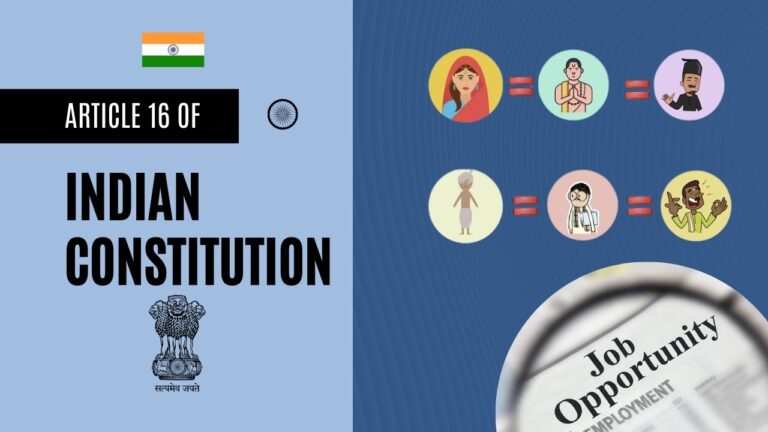Article 13 of Indian Constitution: Laws inconsistent with or in derogation of the fundamental rights
Original Text of Article 13 of Indian Constitution:
(1) All laws in force in the territory of India immediately before the commencement of this Constitution, in so far as they are inconsistent with the provisions of this Part, shall, to the extent of such inconsistency, be void.
(2) The State shall not make any law that takes away or abridges the rights conferred by this Part, and any law made in contravention of this clause shall, to the extent of the contravention, be void.
(3) In this article, unless the context otherwise requires,—
- “law” includes any Ordinance, order, bye-law, rule, regulation, notification, custom or usage having in the territory of India the force of Law;
- “laws in force” includes laws passed or made by a Legislature or other competent authority in the territory of India before the commencement of this Constitution and not previously repealed, notwithstanding that any such law or any part thereof may not be then in operation either at all or in particular areas.
(4) Nothing in this article shall apply to any amendment of this Constitution made under article 368.]
Article 13 of Indian Constitution Explanation:
Article 13 of Indian Constitution– Laws Inconsistent with Fundamental Rights:
Article 13 addresses all laws that are inconsistent with fundamental rights or derogate them. According to it, all such provisions of laws in force before the commencement of this Constitution that are not consistent with the provisions of Part III of the Constitution shall become void.
Further, the Parliament and State legislatures are prohibited from making any law that takes away fundamental rights.
Hence, it forms the basis of the judicial review doctrine and aids the court and citizens in checking the misuse of powers by the legislature and executive.
What constitutes as a law?
The term ‘Law‘, which cannot be inconsistent with Part III of the Constitution, covers the following types of laws:
- Permanent lawsthat are enacted by the Parliament of India or legislatures of the states.
- Temporary laws, like ordinancesby the President or the governors of the State.
- Statutory instrumentslike delegated legislation, i.e. executive legislation, as regulation or notification, order, rule or by-law.
- Non-legislative sources of Law, i.e. customs with the force of Law.
Can Constitutional amendments be Judicially reviewed if they are inconsistent with the Constitution?
Article 13 of Indian Constitution does not list constitutional amendments as laws; hence, for a long time, it was believed that they could not be challenged and that the Parliament was fully competent to make any amendment. [Shankari Prasad Case, 1951]
This led to several changes even in Part III of the Constitution. A very concerned Supreme Court, then in the Golaknath Case, 1967, stated that the Parliament is not a Constituent Assembly. A Constitutional amendment is a legislative process and comes under the definition of ‘Law’ in Article 13. Thus, all constitutional amendments must be consistent with Part III (Fundamental Rights). And therefore, fundamental Rights were “Transcendental and Immutable”.
24th Amendment Act, 1971 inserted an additional Clause in Article 13(clause 13(4)) that constitutional amendment should not be covered in the definition of ‘Law’. This was done to prevent the amendments in Part III of the Constitution from being challenged in the Supreme Court on the argument of ‘inconsistency’ with Part III.
In the Kesavanand Bharti case (1973), the Supreme Court accepted the 24th amendment, once again making it competent for the Parliament to amend the fundamental Right. However, these amendments could not violate the ‘Basic structure’ of the Constitution and, therefore, could be challenged in the Supreme Court.
Doctrines Related to Article 13
Over the years, the Supreme Court has established certain doctrines related to Fundamental Rights:
1. The doctrine of severability:
The Doctrine of Severability, linked to Article 13 of the Constitution of India, was established by the Supreme Court to address the constitutionality of Laws. It allows for the judicial review of any law or Part thereof that is deemed unconstitutional or in violation of fundamental rights. According to this doctrine, a law declared void is only so to the extent of its inconsistency with the fundamental rights of the Constitution of India.
The doctrine asserts that if a part of a law conflicts with fundamental rights, only that offending Part is declared void, not the entire Law in the act or a statute. The primary aim is to remove only the offending provision that violates fundamental rights, not the entire Law.
However, If the entire Law hinges on a provision that violates fundamental rights, and removing such a provision that violates fundamental rights, and removing such a provision renders the whole Law useless, the court has the authority to declare the entire law void if it’s impossible to separate the offending provision.
In short, If a law violates Fundamental Rights, only the inconsistent sections will be struck down.
2. Doctrine of Eclipse
Pre-constitutional laws that are violations of Part III or any article of it shall be eclipsed by the provisions of Part III.
The Doctrine of Eclipse is articulated in Article 13(1) of the Constitution of India. This article mandates that any law enacted before the Constitution came into effect must align with Part III of the Constitution of India. If a statute conflicts with the provisions of Part III, it becomes void. However, such a statute isn’t considered dead but remains in a dormant state until the Parliament repeals it.
Therefore, any pre-independence law that violates or conflicts with fundamental rights should be void to the extent of that inconsistency. It doesn’t render the entire law void, but only that Part that conflicts with part III of the Constitution of India. The Law isn’t dead but remains dormant and is subject to parliamentary discretion.
For further reference:
Read the constitution of India.

